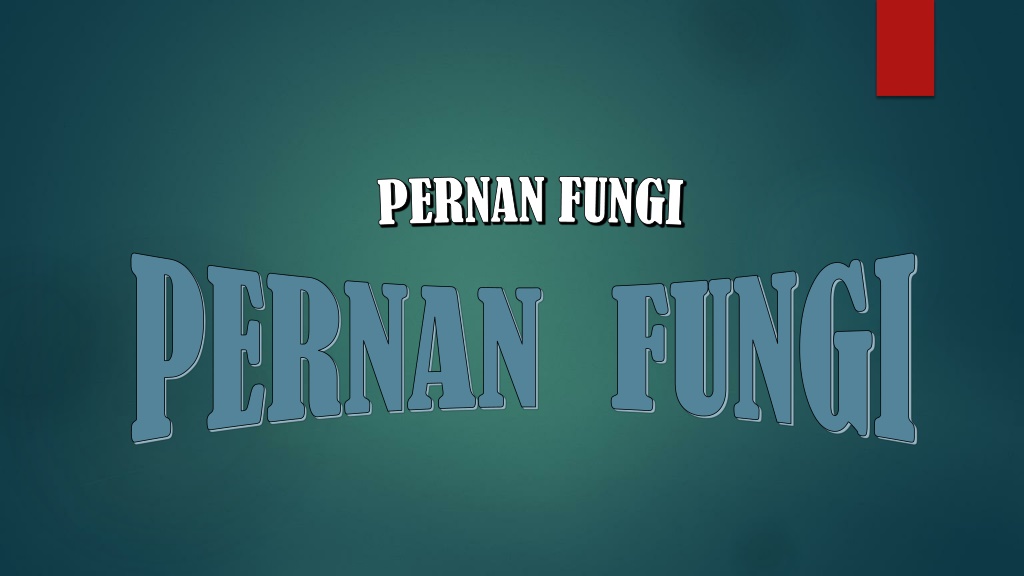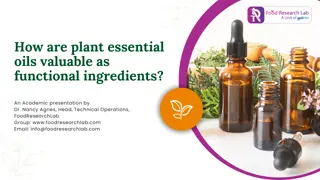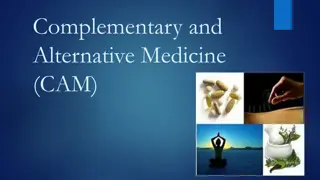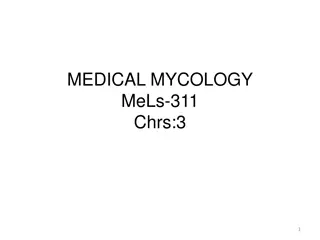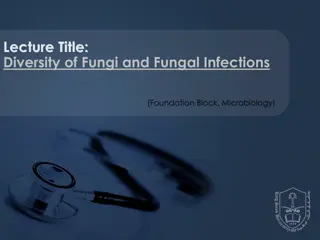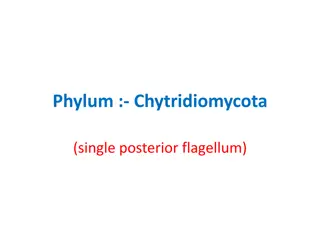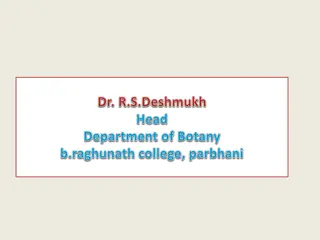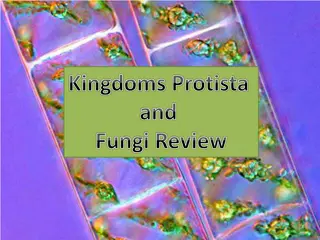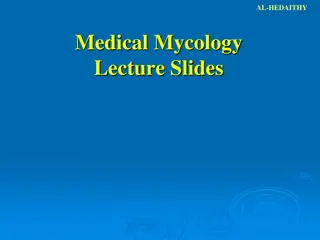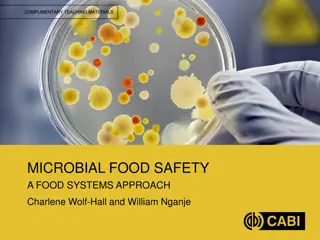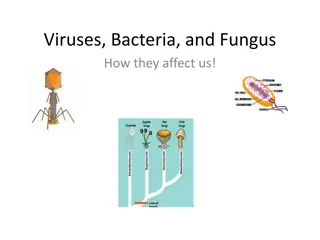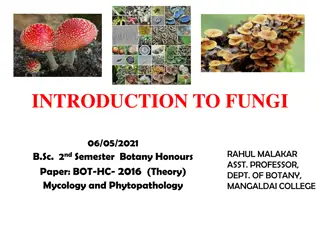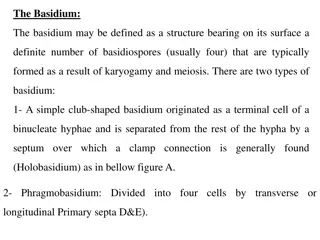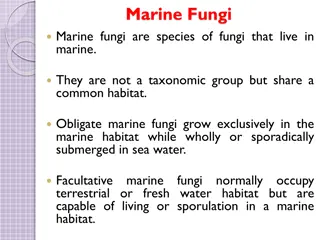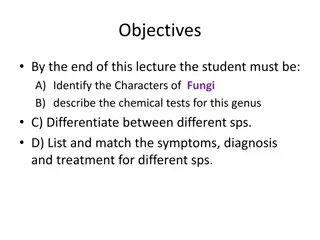Benefits and Risks of Fungi in Medicine and Food Industry
Fungi play a significant role in both medicine and food industry. Beneficial fungi are involved in the production of antibiotics and food items like tempe and edible mushrooms, while harmful fungi can cause diseases in humans and plants. The discovery of antibiotics derived from fungi has revolutionized healthcare globally. Additionally, certain fungi have been traditionally used as medicines, and some chemical compounds isolated from fungi hold potential in treating cancer. On the other hand, pathogenic fungi can pose health risks to humans and animals. Understanding the dual nature of fungi is crucial in managing their impact on various aspects of life.
Download Presentation

Please find below an Image/Link to download the presentation.
The content on the website is provided AS IS for your information and personal use only. It may not be sold, licensed, or shared on other websites without obtaining consent from the author. Download presentation by click this link. If you encounter any issues during the download, it is possible that the publisher has removed the file from their server.
E N D
Presentation Transcript
P PE ER RN NA AN N F FU UN NG GI I PERNAN FUNGI PERNAN FUNGI
A.Bermanfaat / menguntungkan B. Merugikan Yang bermanfaat diantaranya adalah : Fermentasi alcohol, pembuatan tempe, menghasilkan antibiotik (Penicillium notatum). Jamur yang bisa dimakan edible Mushrom (Volvariella volvacea, Pleurotus ostreatus) dll Sebagai sumber obat-obatan Sebagai pengurai bahan organik Sebagai pengendali penyakit secara hayati
Yang merugikan diantaranya : - yang bersifat pathogen pada manusia - merusak perabot, penyakit tumbuhan
YANG MENGUNTUNGKAN : DI BIDANG MEDIS Penicillin, perhaps the most famous of all antibiotic drugs, is derived from a common fungus called Penicillium. Many other fungi also produce antibiotic substances which are now widely used to control diseases in human and animal populations. The discovery of antibiotics revolutionized health care worldwide. Some fungi which parasitise caterpillars have also been traditionally used as medicines. The Chinese have used a particular caterpillar fungus as a tonic for hundreds of years. Certain chemical compounds isolated from the fungus may prove to be useful treatments for certain types of cancer. A fungus which parasitises Rye crops causes a disease known as Ergot. The fungus can occur on a variety of grasses. It produces small hard structures, known as sclerotia. These sclerotia can cause poisoning in humans and animals which have eaten infected material. However, these same sclerotia are also the source of a powerful and important drug which has uses in childbirth.
MEDIS Penicillin, perhaps the most famous of all antibiotic drugs, is derived from a common fungus called Penicillium. Many other fungi also produce antibiotic substances, which are now widely used to control diseases in human and animal populations. The discovery of antibiotics revolutionized health care worldwide. Some fungi which parasitise caterpillars have also been traditionally used as medicines. The Chinese have used a particular caterpillar fungus as a tonic for hundreds of years. Certain chemical compounds isolated from the fungus may prove to be useful treatments for certain types of cancer.
MEDIS A fungus which parasitises Rye crops causes a disease known as Ergot. The fungus can occur on a variety of grasses. It produces small hard structures, known as sclerotia. These sclerotia can cause poisoning in humans and animals which have eaten infected material. However, these same sclerotia are also the source of a powerful and important drug which has uses in childbirth
FOOD (INDUSTRI MAKANAN) Fungi are also important directly as food for humans. Many mushrooms are edible and different species are cultivated for sale worldwide. While this is a very small proportion of the actual food that we eat, fungi are also widely used in the production of many foods and drinks. These include cheeses, beer and wine, bread, some cakes, and some soya bean products. While a great many wild fungi are edible, it can be difficult to correctly identify them. Some mushrooms are deadly if they are eaten. Fungi with names such as 'Destroying Angel' and 'Death Cap' give us some indication that it would not be a terribly good idea to eat them! In some countries, collecting wild mushrooms to eat is a popular activity. It is always wise to be totally sure that what you have collected is edible and not a poisonous look-a-like.
The usage of fungi for food, preservation or other purposes by humans are wide- ranging and has a rich history. For example, yeasts are used to ferment beer, wine and bread; while some other species, for example, the Aspergillus oryzae, are used in the production of soy sauce and Rhizopus oryzae used for tempeh, a food product made from soya beans, with different nutritional characteristicsa and textural qualities. Saccharomyces cerevisiae (also known as baker s yeast), a single cell fungus, is used in the baking of bread and other wheat-based products such as pizza and dumplings. It is also used for the production of alcoholic beverages through fermentation. Several species, such as the Agaricus bisporus (jamur kancing) and the Portobello are sold as button mushrooms for consumption. There are many more mushroom species that are harvested from the wild for personal consumption or commercial sale. Milk mushrooms, morels, chanterelles, truffles, black trumpets, and porcini mushrooms all demand a high price on the market and are often used in gourmet dishes.
For certain types of cheeses (Penicillium requeforti), it is also a common practice to inoculate milk curds with fungal spores to forment the growth of a specific species of mould that impart a unique flavour and textures to the cheese, this accounts for the blue colour in cheeses such as Stilton of Roquefort. The moulds used in cheese production are usually non-toxic and are thus safe for human comsumption; however, mycotoxins may accumulate due to fungal spoilage during cheese rippening or storage. Soya sauce Aspergillus oryzae, Pediococcus soyae, Saccharomyces rouxii Yeasts Saccharomyces cerevisae, e.g. wine and vodka
LINGKUNGAN Jaring makanan tidak akan lengkap tanpa organisme yang menguraikan bahan organik. Beberapa elemen, seperti nitrogen dan fosfor, yang diperlukan dalam jumlah besar oleh sistem biologis; Namun, mereka tidak melimpah di lingkungan. Tindakan jamur melepaskan unsur ini dari proses pembusukan, membuat mereka tersedia bagi organisme hidup lainnya. Elemen ini dierlukan dalam jumlah rendah di banyak habitat dan penting untuk pertumbuhan, tetapi elemen ini akan tetap terikat dalam bahan organik yang membusuk jika jamur dan bakteri tidak mengembalikan mereka ke lingkungan melalui aktivitas metabolisme mereka. Jamur merupakan bagian penting dari siklus hara ekosistem. Jamur braket (keranjang) tumbuh di sisi pohon yang berupa tubuh buah dari basidiomycete. Mereka menerima nutrisi mereka melalui hifa mereka, yang menyerang dan pembusukan batang pohon.
jamur mampu menguraikan molekul komplek menjadi molekul sederhana pada saat megambil nutrisi dari substratnya. Jamur menghasilkan berbagai exoenzymes untuk mencerna nutrisi. Enzim dilepaskan ke substrat atau tetap terikat ke luar dinding sel jamur. Molekul besar dipecah menjadi molekul kecil, yang diangkut ke dalam sel oleh sistem operator proteinyang tertanam dalam membran sel. Karena pergerakan molekul kecil dan enzim tergantung pada keberadaan air, pertumbuhan aktif tergantung pada persentase yang relatif tinggi kelembaban lingkungan. Sebagai saprob, jamur membantu menjaga ekosistem berkelanjutan untuk hewan dan tumbuhan yang berbagi habitat yang sama. jamur berinteraksi langsung dengan organisme lain dengan cara yang menguntungkan, tapi kadang-kadang merusak,.
Recycling (daur ulang) Fungi, together with bacteria, are responsible for most of the recycling which returns dead material to the soil in a form in which it can be reused. Without fungi, these recycling activities would be seriously reduced. We would effectively be lost under piles many metres thick, of dead plant and animal remains. Mycorrhizae and plant growth Fungi are vitally important for the good growth of most plants, including crops, through the development of mycorrhizal associations. As plants are at the base of most food chains, if their growth was limited, all animal life, including human, would be seriously reduced through starvation.
BIOCONTROL Fungi such as the Chinese caterpillar fungus, which parasitise insects, can be extremely useful for controlling insect pests of crops. The spores of the fungi are sprayed on the crop pests. Fungi have been used to control Colorado potato beetles, which can devastate potato crops. Spittlebugs, leaf hoppers and citrus rust mites are some of the other insect pests which have been controlled using fungi. This method is generally cheaper and less damaging to the environment than using chemical pesticides.
Fungi in the biological control of pests In agriculture, fungi that competes for nutrients and space with, and eventually prevail over, pathogenic microorganisms, such as bacteria or other fungi, via the competitive exclusion principle, or are parasites of pathogens, may be beneficial agents for human use. Some fungi may be used to suppress growth or eliminate harmful plant pathogens, such as insects, mites, weeds, nematodes and other fungi that cause diseases of important crop plants. Entomopathogenic fungi can be used as biopesticides, for they actively kill insects. Examples of fungi that have been used widely as biopesticides are Beauveria bassiana, Metarhizium anisopliae, Paecilomyces spp and Verticillum lecanii
YANG MERUGIKAN o Dapat menurunkan kualitas maupun kuantitas makanan maupun bahan-bahan lain yang penting bagi manusia. o Fungi dapat juga menyerang bahan-bahan lain yang bernilai ekonomi seperti kulit, kayu, tekstil dan bahan-bahan baku pabrik lainnya. o Fungi juga dapat berperan sebagai agen penyebab penyakit. Fungi pada umumnya lebih sering menyebabkanpenyakit pada tumbuhan dibanding pada hewan atau manusia o Fungi dapat menghasilkan racun, racun yang dihasilkan beberapa fungi seperti seperti Amanita phalloides, A. muscaria maupun Aspergillus flavus (menghasilkan aflatoksin), dapat sangat berbahaya bagi manusia karena dapat menyebabkan penyakit kronis seperti kanker dan bahkan kematian.
CROP DISEASE Fungal parasites may be useful in biocontrol, but they can also have enormous negative consequences for crop production. Some fungi are parasites of plants. Most of our common crop plants are susceptible to fungal attack of one kind or another. Spore production and dispersal is enormously efficient in fungi and plants of the same species crowded together in fields are ripe for attack. Fungal diseases can on occasion result in the loss of entire crops if they are not treated with antifungal agents. Animal Disease Fungi can also parasitise domestic animals causing diseases, but this is not usually a major economic problem. A wide range of fungi also live on and in humans, but most coexist harmlessly. Athletes foot and Candida infections are examples of human fungal infections.
FOOD SPOILAGE It has already been noted that fungi play a major role in recycling organic material. The fungi which make our bread and jam go mouldy are only recycling organic matter, even though in this case, we would prefer that it didn't happen! Fungal damage can be responsible for large losses of stored food, particularly food which contains any moisture. Dry grains can usually be stored successfully, but the minute they become damp, moulds are likely to render them inedible. This is obviously a problem where large quantities of food are being produced seasonally and then require storage until they are needed.
